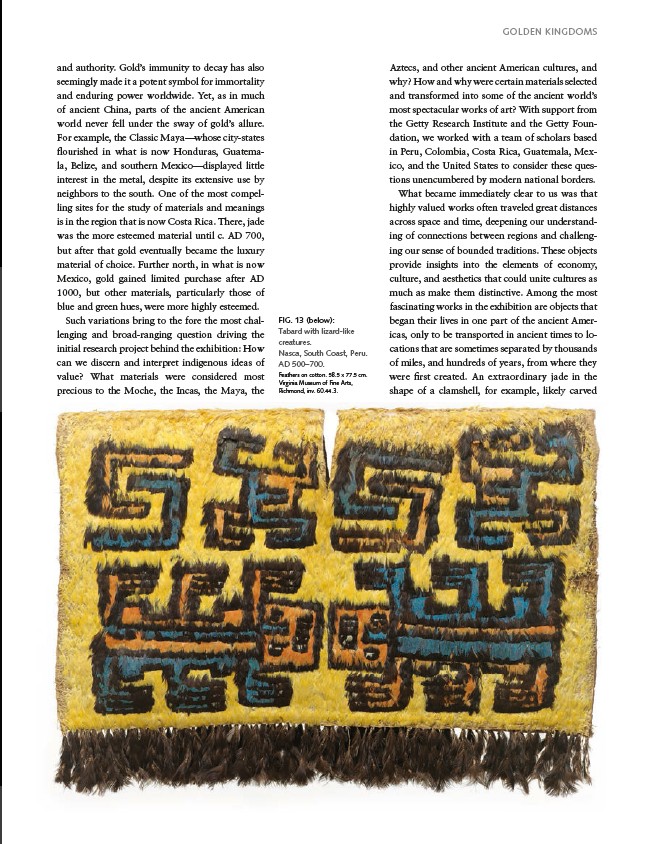
83
FIG. 13 (below):
Tabard with lizard-like
creatures.
Nasca, South Coast, Peru.
AD 500–700.
Feathers on cotton. 58.5 x 77.5 cm.
Virginia Museum of Fine Arts,
Richmond, inv. 60.44.3.
GOLDEN KINGDOMS
and authority. Gold’s immunity to decay has also
seemingly made it a potent symbol for immortality
and enduring power worldwide. Yet, as in much
of ancient China, parts of the ancient American
world never fell under the sway of gold’s allure.
For example, the Classic Maya—whose city-states
flourished in what is now Honduras, Guatemala,
Belize, and southern Mexico—displayed little
interest in the metal, despite its extensive use by
neighbors to the south. One of the most compelling
sites for the study of materials and meanings
is in the region that is now Costa Rica. There, jade
was the more esteemed material until c. AD 700,
but after that gold eventually became the luxury
material of choice. Further north, in what is now
Mexico, gold gained limited purchase after AD
1000, but other materials, particularly those of
blue and green hues, were more highly esteemed.
Such variations bring to the fore the most challenging
and broad-ranging question driving the
initial research project behind the exhibition: How
can we discern and interpret indigenous ideas of
value? What materials were considered most
precious to the Moche, the Incas, the Maya, the
Aztecs, and other ancient American cultures, and
why? How and why were certain materials selected
and transformed into some of the ancient world’s
most spectacular works of art? With support from
the Getty Research Institute and the Getty Foundation,
we worked with a team of scholars based
in Peru, Colombia, Costa Rica, Guatemala, Mexico,
and the United States to consider these questions
unencumbered by modern national borders.
What became immediately clear to us was that
highly valued works often traveled great distances
across space and time, deepening our understanding
of connections between regions and challenging
our sense of bounded traditions. These objects
provide insights into the elements of economy,
culture, and aesthetics that could unite cultures as
much as make them distinctive. Among the most
fascinating works in the exhibition are objects that
began their lives in one part of the ancient Americas,
only to be transported in ancient times to locations
that are sometimes separated by thousands
of miles, and hundreds of years, from where they
were first created. An extraordinary jade in the
shape of a clamshell, for example, likely carved